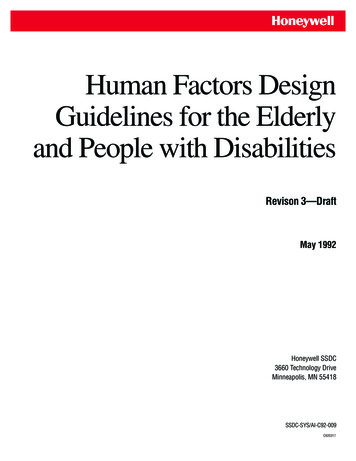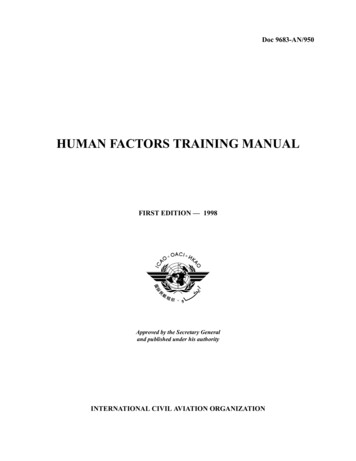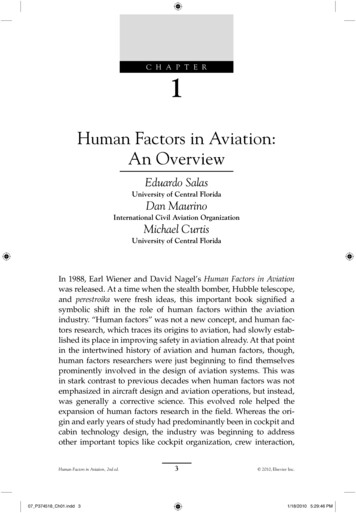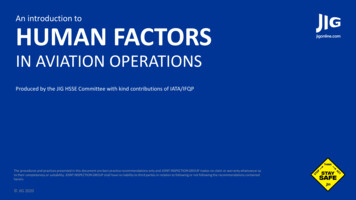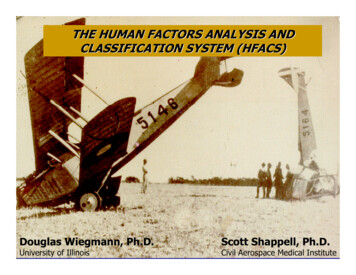
Transcription
THE HUMAN FACTORS ANALYSIS ANDCLASSIFICATION SYSTEM (HFACS)Douglas Wiegmann, Ph.D.University Shappell & Wiegmann, of2002 IllinoisScott Shappell, Ph.D.Civil Aerospace Medical Institute
Shappell & Wiegmann, 2002
U.S. General AviationScheduled Air Carrier50Accidents/100,000 flight hours5040302010302010Source: BoeingSource: NTSBU.S. Navy/Marine CorpsU.S. Air Force6040Accidents/100,000 flight hours50403020100302010Source: U.S. Naval Safety Center Shappell & Wiegmann, 950Accidents/100,000 flight ource: U.S. Air Force Safety Center
REASONS FOR CONCERN¾ The rate of improvement has slowed significantly andsubstantially during the last 25 years. This has led some to conclude that furtherreductions in accident rates are improbable, ifnot impossible. Shappell & Wiegmann, 2002
REASONS FOR CONCERN¾ The rate of improvement has slowed significantly andsubstantially during the last 10 years. This has led some to conclude that furtherreductions in accident rates are improbable, if notimpossible.¾ Still, aircraft are becoming increasingly expensiveraising the cost of aviation accidents. Shappell & Wiegmann, 2002
COST OF ACCIDENTSU.S. Navy and Marine CorpsFY96-00Aviation 3.3BRecreation 67MPMV 129MTotal: 3.9 Billion Shappell & Wiegmann, 2000Shore/Ground 150MShipboard 277MSource:Source: U.S.U.S. NavalNaval SafetySafety CenterCenter
U.S. Navy/Marine Corps (1950-2000)60Accidents/100,000 flight hours5040302010Source: U.S. Naval Safety Center Shappell & Wiegmann, 20022000199019801970196019500
All NAVY/MARINE Class A, B, & C MishapsClass A, B,& C Mishaps/100,000 Flight 831981197919770YearShappell, S. and Wiegmann, D. (1996). U.S. Naval aviation mishaps 1977-1992: Differences between single and dualpiloted aircraft. Aviation, Space, and Environmental Medicine, 67, 65-69. Shappell & Wiegmann, 2002
Research SponsorsInterventionand PreventionProgramsMechanicalFailure- Catastrophic failuresare infrequentevents- When failures dooccur, they are oftenless severe orhazardous due onEffectiveData-DrivenResearch- FAA, DoD, NASA, & airplanemanufacturers provideresearch funding.- Research programs are needsbased and data-driven.Interventions are thereforevery effective.AccidentInvestigationAccidentDatabase- Highly sophisticatedtechniques andprocedures- Designed aroundtraditionalcategories- Information isobjective andquantifiable- Variables are welldefined andcausally related- Effective atdetermining why thefailure occurred- Organization andstructure facilitateaccess and useDatabaseAnalysis- Traditionalanalyses areclearly outlinedand readilyperformed.- Frequent analyseshelp identifycommonmechanical andengineeringsafety issues.FeedbackWiegmann, D. & Shappell, S. (2001). Human error analysis of commercial aviation accidents: Application of the HumanFactors Analysis and Classification System (HFACS). Aviation, Space, and Environmental Medicine,72, 1006-1016. Shappell & Wiegmann, 2002
Research SponsorsInterventionand PreventionProgramsHumanError- Errors occurfrequently and arethe major cause ofaccidents.- Few safety programsare effective atpreventing theoccurrence orconsequences ofthese search- FAA, DoD, NASA, & Airlinesprovide funding for safetyresearch programs.- Lack of good data leads toresearch programs basedprimarily on interests andintuitions. Interventions aretherefore less effective.AccidentInvestigation- Less sophisticatedtechniques andprocedures- Information isqualitative andillusive- Focus on “what”happened but not“why” it happenedAccidentDatabase- Not designedaround anyparticular humanerror framework- Variables often illdefined- Organization andstructure difficultto understandDatabaseAnalysis- Traditional humanfactors analysesare onerous dueto ill-definedvariables anddatabasestructures.- Few analyses havebeen performedto identifyunderlyinghuman factorssafety issues.FeedbackWiegmann, D. & Shappell, S. (2001). Human error analysis of commercial aviation accidents: Application of the HumanFactors Analysis and Classification System (HFACS). Aviation, Space, and Environmental Medicine,72, 1006-1016. Shappell & Wiegmann, 2002
ADDRESSING THE PROBLEM¾ What was required, therefore, was a generalhuman error framework around which accidentinvestigation and prevention programs can bedeveloped.¾ We explored several approaches and “off-theshelf” frameworks tionalShappell, S. and Wiegmann, D. Controlled flight into terrain: The utility of an information processing approach to mishapcausal factors. Proceedings of the Eighth Symposium for Aviation Psychology, Ohio State University, 1300-1306, 1995.Wiegmann, D and Shappell, S. Human factors in U.S. Naval aviation mishaps: An information processing approach.Proceedings of the Eighth Symposium for Aviation Psychology, Ohio State University, 1995.Wiegmann, D. and Shappell, S. Human factors analyses of post-accident data: Applying theoretical taxonomies of humanerror. International Journal of Aviation Psychology, 7, 67-81, 1997.Wiegmann, D. and Shappell, S. Human error perspectives in aviation. International Journal of Aviation Psychology, 11, 341357, 2001. Shappell & Wiegmann, 2002
The Human Factors Analysis and ClassificationSystem (HFACS)Shappell, S. and Wiegmann, D. A human error approach to accident investigation: The Taxonomy of Unsafe Operations. InternationalJournal of Aviation Psychology, 7, 269-291, 1998.Shappell, S. and Wiegmann, D. Human factors analysis of aviation accident data: Developing a needs-based, data-driven, safety program.Proceedings of the HESSD, Brussels, Belgium, 1999.Shappell, S. and Wiegmann, D. The Human Factors Analysis and Classification System – HFACS. Office of Aviation Medicine TechnicalReport No. DOT/FAA/AM-00/7. Civil Aeromedical Institute, Oklahoma City, OK 73125, 2000.Shappell, S. and Wiegmann, D. Beyond Reason: Defining the holes in the Swiss Cheese. Human Factors in Aviation Safety, (in press), 2000. Shappell & Wiegmann, 2002
Breakdown of a Productive SystemUnsafeActsFailed orAbsent DefensesAdapted from Reason (1990) Shappell & Wiegmann, 2002Active Conditions Failed to scan instruments Penetrated IMC when VFR only
Breakdown of a Productive SystemPreconditionsforUnsafe ActsActive and Latent Conditions Poor CRM Loss of situational awarenessUnsafeActsFailed orAbsent DefensesAdapted from Reason (1990) Shappell & Wiegmann, 2002Active Conditions Failed to scan instruments Penetrated IMC when VFR only
Breakdown of a Productive SystemUnsafeSupervisionLatent Conditions Deficient training program Improper crew pairingPreconditionsforUnsafe ActsActive and Latent Conditions Poor CRM Loss of situational awarenessUnsafeActsFailed orAbsent DefensesAdapted from Reason (1990) Shappell & Wiegmann, 2002Active Conditions Failed to scan instruments Penetrated IMC when VFR only
Breakdown of a Productive SystemInputs EconomicinflationOrganizationalFactorsLatent Conditions Excessive cost cutting Inadequate promotion policies Few qualifiedpilotsUnsafeSupervisionLatent Conditions Deficient training program Improper crew pairingPreconditionsforUnsafe ActsActive and Latent Conditions Poor CRM Loss of situational awarenessUnsafeActsFailed orAbsent DefensesActive Conditions Failed to scan instruments Penetrated IMC when VFR onlyAccident & Injury Crashed into side ofmountainAdapted from Reason (1990) Shappell & Wiegmann, 2002
ErrorsUnsafeActs Shappell & Wiegmann, ional
ErrorsSkill-BasedErrorsPerceptualErrorsDECISION ERRORSUnsafeActs Shappell & Wiegmann, 2002¾ Rule-based Decisions- If X, then do Y- Highly Procedural¾ Choice Decisions- Knowledge-based¾ Ill-Structured Decisions- Problem solvingRoutineExceptional
ErrorsUnsafeActs Shappell & Wiegmann, BASEDERRORS¾ Attention Failures- Breakdown in visual scan- Inadvertent operation of control¾ Memory Failure- Omitted item in checklist- Omitted step in procedure¾ Stick-and-Rudder SkillsExceptional
ERCEPTUALERRORS(due to)¾ Misjudge Distance,Altitude, Airspeed¾ Spatial Disorientation¾ Visual Illusions Shappell & Wiegmann, 2002RoutineExceptional
INE (INFRACTIONS)(Habitual departures from rules condoned by management)UnsafeActs Shappell & Wiegmann, 2002¾ VFR Flight into IMC¾ Elected to File VFR in Marginal Weather Conditions¾ Failed to Use Radar Advisories from ATC¾ Inadequate Brief and Limits on Mission¾IFR Procedure Not Followed¾Weight and Balance Exceeded¾Procedure/Directives Not Followed¾Operating With Known Deficiencies¾Min. Descent Altitude not Complied withExceptional
ptionalEXCEPTIONAL(Isolated departures from the rules not condonedby management)UnsafeActs Shappell & Wiegmann, 2002¾ Violated NATOPS/Regulations/SOP- Performed Unauthorized Acrobatic Maneuver- Canyon Running- Failed to Complete Performance Computations for Flight- Failed to Obtain Valid Weather Brief¾ Accepted Unnecessary Hazard¾ Not Current/Qualified for Mission¾ Exceeded Limits of Aircraft
PRECONDITIONSFORUNSAFE ogicalEnvironmentPreconditionsforUnsafe ActsUnsafeActs Shappell & Wiegmann, 2002PersonnelFactorsCondition StatesPhysical/MentalLimitationsCrew ResourceManagementPersonalReadiness
PRECONDITIONSFORUNSAFE ogicalEnvironmentPersonnelFactorsCondition safe ActsUnsafeActs Shappell & Wiegmann, 2002ADVERSE MENTAL STATE¾ Loss of Situational Awareness¾ Circadian dysrhythmia¾ Alertness (Drowsiness)¾ Overconfidence¾ Complacency¾ Task FixationCrew ResourceManagementPersonalReadiness
PRECONDITIONSFORUNSAFE ogicalEnvironmentPreconditionsforUnsafe ActsUnsafeActs Shappell & Wiegmann, 2002PersonnelFactorsCondition StatesPhysical/MentalLimitationsADVERSE PHYSIOLOGICALSTATES¾ Spatial Disorientation¾ Visual Illusions¾ G-induced Loss of Consciousness¾ Hypoxia¾ Medical IllnessCrew ResourceManagementPersonalReadiness
PRECONDITIONSFORUNSAFE ogicalEnvironmentPreconditionsforUnsafe ActsUnsafeActsPersonnelFactorsCondition ITATIONS¾ Lack of Sensory Input¾ Limited Reaction Time¾ Incompatible Physical Capabilities¾ Incompatible Intelligence/Aptitude Shappell & Wiegmann, 2002Crew ResourceManagementPersonalReadiness
PRECONDITIONSFORUNSAFE ogicalEnvironmentPreconditionsforUnsafe ActsUnsafeActs Shappell & Wiegmann, 2002PersonnelFactorsCondition StatesPhysical/MentalLimitationsCrew ResourceManagementCREW RESOURCEMANAGEMENT¾ Not Working as a Team¾ Poor Aircrew Coordination¾ Improper Briefing Before a Mission¾ Inadequate Coordination of FlightPersonalReadiness
PRECONDITIONSFORUNSAFE ogicalEnvironmentPreconditionsforUnsafe ActsPersonnelFactorsCondition StatesPhysical/MentalLimitationsPERSONAL READINESSUnsafeActs Shappell & Wiegmann, 2002Readiness Violations¾ Crew Rest Requirements¾ Bottle-to-Brief Rules¾ Self-MedicatingPoor Judgement¾ Poor Dietary Practices¾ Overexertion While Off DutyCrew ResourceManagementPersonalReadiness
PRECONDITIONSFORUNSAFE ogicalEnvironmentPreconditionsforUnsafe ActsPersonnelFactorsCondition StatesPhysical/MentalLimitationsPHYSICAL ENVIRONMENTUnsafeActs Shappell & Wiegmann, 2002¾ Weather¾ Lighting¾ Noise¾ Heat¾ Acceleration¾ Vibration¾ PollutantsCrew ResourceManagementPersonalReadiness
PRECONDITIONSFORUNSAFE ogicalEnvironmentPreconditionsforUnsafe ActsUnsafeActs Shappell & Wiegmann, 2002PersonnelFactorsCondition ONMENT¾ Equipment and controls¾ Automation reliability/complexity¾ Task and Procedure Design¾ Manuals and Checklist Design¾ Interfaces and DisplaysCrew ResourceManagementPersonalReadiness
isionUnsafeSupervisionPreconditionsforUnsafe ActsUnsafeActs Shappell & Wiegmann, 2002PlannedInappropriateOperationsFailed toCorrectProblemSupervisoryViolations
isionUnsafeSupervisionFailed toCorrectProblemINADEQUATE SUPERVISION¾ Failure to Administer Proper Training¾ Lack of Professional GuidancePreconditionsforUnsafe ActsUnsafeActs Shappell & Wiegmann, tions
isionUnsafeSupervisionFailed toCorrectProblemSupervisoryViolationsPLANNED INAPPROPRIATEOPERATIONSPreconditionsforUnsafe Acts¾ Mission Risk without Benefit¾ Improper Work Tempo¾ Poor Crew PairingUnsafeActs Shappell & Wiegmann, 2002PlannedInappropriateOperations
isionUnsafeSupervisionFailed toCorrectProblemSupervisoryViolationsFAILED TO CORRECT AKNOWN PROBLEM¾ Failure to Correct Inappropriate Behavior¾ Failure to Correct a Safety HazardPreconditionsforUnsafe ActsUnsafeActs Shappell & Wiegmann, 2002PlannedInappropriateOperations
isionUnsafeSupervisionFailed toCorrectProblemSupervisoryViolationsSUPERVISORY VIOLATIONS¾ Not Adhering to Rules and Regulations¾ Willful Disregard for Authority bySupervisorsPreconditionsforUnsafe ActsUnsafeActs Shappell & Wiegmann, 2002PlannedInappropriateOperations
encesUnsafeSupervisionPreconditionsforUnsafe ActsUnsafeActs Shappell & Wiegmann, 2002OperationalProcess
encesRESOURCE MANAGEMENT¾ Human¾ Monetary¾ rUnsafe ActsUnsafeActs Shappell & Wiegmann, 2002OperationalProcess
TEOrganizationalInfluences¾ Structure¾ Policies¾ CultureUnsafeSupervisionPreconditionsforUnsafe ActsUnsafeActs Shappell & Wiegmann, 2002OperationalProcess
encesOPERATIONALPROCESSUnsafeSupervision¾ Operations¾ Procedures¾ OversightPreconditionsforUnsafe ActsUnsafeActs Shappell & Wiegmann, 2002OperationalProcess
onFailed FORUNSAFE ogicalEnvironmentPersonnelFactorsCondition StatesPhysical/MentalLimitationsCrew ResourceManagementUNSAFEACTSErrors Shappell & Wiegmann, ptualErrorsRoutineExceptionalPersonalReadiness
Shappell & Wiegmann, 2002
Intervention: Filling the Holes in the SupervisionPreconditionsPreconditionsforSafe ActsUnsafeActsUnsafeSafeActs Shappell & Wiegmann, 2002
U.S. NAVY/MARINE CORPSAVIATION ACCIDENT DATAShappell, S. and Wiegmann, D. Is proficiency eroding among U.S. Naval aircrews? A quantitative analysis using theHuman Factors Analysis and Classification System. Proceedings of the 44th Annual Meeting of the Human Factorsand Ergonomics Society,Society, San Diego, California, 2000.Shappell, S., Squier,Squier, H., Abad,Abad, G., and Wiegmann, D. An analysis of U.S. Navy and Marine Corps mishaps using thefailure analysis classification system: Implications for prevention.prevention. 69th Annual Meeting of the Aerospace MedicalAssociation,Association, 1998.Shappell, S., Wiegmann, D., Fraser, J., Gregory, G., Kinsey, P., and Squier,Squier, H. Beyond mishap rates: A human factorsanalysis of U.S. Navy/Marine Corps TACAIR and Rotary Wing mishapsmishaps using HFACS. 70th70th Annual Meeting of theAerospace Medical Association,Association, 1999.Shappell, S., Wiegmann, D., Fraser, J., Tanner, G., Kinsey, P., and Reddix,Reddix, M. Tracking aircrew error trends in Navalaviation mishaps using HFACS. 71st Annual Meeting of the Aerospace Medical Association,Association, 2000. Shappell & Wiegmann, 2002
Sample of the Types of Human Error Typically FoundAircraft Control Not MaintainedProcedures/Directives Not FollowedAbort DelayedAirspeed (VREF) Not MaintainedAPU SelectedProper Touchdown Point MisjudgedAbort Above V1 ImproperAirspeed (VMC) Not MaintainedAutopilot Improper Use OfComplacencyControl Interference InadvertentCrew/Group Coordination Not MaintainedProper Touchdown Point Not AttainedAirspeed Not MaintainedAirspeed (VR) ImproperAutopilot Inadvertent DeactivationCircuit Breaker SelectedCompensation for Wind Conditions Not PossibleFlare ImproperUnsafe/Hazardous Condition Not IdentifiedVFR Flight Into IMC AttemptedFlight Into Adverse Weather ContinuedHydraulic System Not SelectedInadequate Surveillance of OperationProper Touchdown Point Not PossibleAborted Takeoff DelayedAirspeed (VLOF) Not AttainedAirspeed ExcessiveAltimeter Setting Not ObtainedAltitude Not MaintainedBecame Lost/DisorientedChecklist Not Complied WithCrew/Group Coordination Not PerformedFlaps Improper Use OfFlare ExcessiveFlight into Known Adverse Weather InitialedGo-Around Not PerformedIdentification of Aircraft Visually DelayedInadequate Substantiation ProcessVisual Separation Not MaintainedMinimum Descent Altitude Not MaintainedWheels Up Landing InadvertentAircraft Preflight Not PerformedAircraft Weight and Balance MisjudgedAltimeter Not UsedChecklist Inaccurate Shappell & Wiegmann, 2002Compensation For Wind Conditions InadequateDescent ExcessiveDistance MisjudgedFlare DelayedGround Loop/Swerve IntentionalRemedial Action DelayedVFR Flight Into IMP InitiatedVisual Lookout Not MaintainedAbort Above V1 PerformedCompensation for Wind Conditions ImproperDirectional Control Not MaintainedDiverted AttentionIce/Frost Removal From Aircraft InadequateIFR Procedure ImproperAircraft Control Not PossibleStall InadvertentInadequate Visual LookoutLack of Familiarity With AircraftLack of Total Experience in Type of AircraftLowering of Flaps PerformedPressureVFR Flight Into IMC InadvertentAborted Takeoff PerformedCommunications Not UnderstoodEmergency Procedure Not FollowedInadequate Weather EvaluationNosewheel Steering ExcessiveProcedure InadequateRotation ExcessiveVFR Flight into IMC ContinuedEmergency Procedure Not PerformedLack of Familiarity with Geographic AreaLevel Off Not AttainedMaintenance, Adjustment ImproperMonitoring InadequatePropeller Feathering Not PerformedRemedial Action Not PossibleVisual/Aural PerceptionPreflight Planning/Preparation InadequateAircraft Handling ImproperCrew/Group Coordination InadequateSpoiler Extension Not PerformedStall/Spin InadvertentAirspeed (VREF) Not AttainedAirspeed (VS) Not MaintainedGo-Around DelayedFatigue (Flight and Ground Schedule)Flight to Alternation Not PerformedOperation with Known Deficiencies in EquipmentSpoiler Extension Inadvertent ActivationSupervision InadequatePlanning/Decision improperRaising of Flaps ImproperIn-Flight Planning/Decision ImproperOverconfidence in Personal AbilityParking Brake Not SetExpectancyFlight Manuals Improper Use OfWrong Taxi Route SelectedGear Extension Not PerformedWeather Evaluation InadequateStall/Mush EncounteredParking Brakes Inadvertent DeactivationIn-Flight Planning/Decision PoorProper Glidepath Not MaintainedAltitude InadequateConditions/Steps Insufficiently DefinedEvacuation ImproperPassenger Briefing InadequateSpatial DisorientationThrottle/Power Control Improper Use OfWeather Evaluation InaccurateWrong Runway SelectedIce/Frost Removal From Aircraft Not IdentifiedPlanned Approach PoorRecovery from Bounced Landing ImproperPlanning/Decision InadequateAircraft Preflight InadequateChecklist InadequateDescent InadvertentGenerator Inadvertent DeactivationTouchdown InadvertentPreflight Planning/Preparation ImproperCompensation for Wind Conditions MisjudgedVisual IllusionUncontrolled DescentProper Descent Rate Not MaintainedChecklist Not UsedAnti-Ice/Deice System Not UsedInadequate MonitoringPowerplant Controls Inadvertent ActivationTraffic Advisory Not IdentifiedClearance MisjudgedIFR Procedure Not FollowedInattentiveRemedial Action AttemptedSomeone GoofedImproper Use of Preflight Briefing ServiceDescent PrematureProper Descent Rate Not AttainedAirspeed Not Maintained (generic)Inadvertent StallVisual Lookout InadequateIce/Frost Removal From Aircraft Nor PerformedInformation InsufficientSelf-Induced PressureTrim Setting ImproperFlight Controls Improper Use OfAltitude/Clearance Not MaintainedManeuver PerformedPreflight Planning/Preparation PoorProper Altitude Not MaintainedFlare InitiatedFlight Advisories Not FollowedAltitude/Clearance InadequateDistance/Altitude MisjudgedInadequate TrainingRotation ImproperUnsuitable Terrain or Takeoff/Landing/Taxi AreaVFR Procedures InadequateProper Alignment Not PossibleRemedial Action ImproperFlare MisjudgedProper Alignment DelayedMissed Approach Not PerformedProper Alignment Not AttainedLack of Total Experience in Type OperationMinimum Descent Altitude BelowMiscellaneous Equipment InitiatedProper Alignment Not MaintainedSupervision ImproperGear Down and Locked Not VerifiedWind Information MisjudgedAircraft Weight and Balance ExceededAircraft Control-UncontrolledCrew/Group Coordination Not AttainedChecklist Not FollowedClearance Not Maintained
Number and Percentage of Mishaps Associated with EachHFACS Causal Category (FY 91-99) Shappell & Wiegmann, 2002USMCn 73USNn 105Count (%)Count (%)Organizational InfluencesResource ManagementOrganizational ClimateOrganizational Process17 (23)0 (0)19 (26)Unsafe SupervisionInadequate SupervisionPlanned Inappropriate OperationsFailed to Correct a Known ProblemSupervisory (10)Preconditions for Unsafe ActsAdverse Mental StatesAdverse Physiological StatesPhysical/Mental LimitationsCrew Resource MismanagementPersonal 26)(10)(66)(5)Unsafe ActsDecision ErrorsSkill-based ErrorsPerceptual 1)(54)(27)(31)32 (30)1 (1)39 (37)
� Violation of Orders/Regulations/SOP- Failed to Inspect ACFT after In-Flight Caution Light- Violated Squadron SOP Restricting Flight Below 500’- Failed to Comply with NATOPS During Streaming- Conducted Night Training and Ops Mission with PAX- Elected to File VFR in Marginal Weather Conditions- Failed to Use Radar Advisories from ATC- Inadequate Brief and Limits on Mission- HAC Knowingly Accepted Non-Current Crew¾ Failed to Adhere to Brief¾ Not Current/Qualified for Mission¾ Improper Procedure Shappell & Wiegmann, 2002
Percentage of Human Error MishapsAssociated with Violations (FY 91-97)ρ -.487, ns50Percentage40302010091 Shappell & Wiegmann, 200292939495Fiscal Year96979899
Intervention Strategy¾ Professionalism¾ Accountability¾ Enforcing the Rules Shappell & Wiegmann, 2002
Percentage of Human Error Mishaps Associated withViolations (FY 91-99)50Percentage40302010091 Shappell & Wiegmann, 200292939495Fiscal Year96979899
ptionalSKILL-BASED ERRORSUnsafeActs Shappell & Wiegmann, 2002¾ Breakdown in Visual Scan¾ Failed to See and Avoid¾ Poor Technique¾ Omitted Checklist Item¾ Inadvertent Operation of Control¾ Improper Use of Flight Controls
Percentage of Human Error Mishaps Associated withSkill-based Errors (FY 91-99)8070Percentage6050ρ .832, p .0140302010091 Shappell & Wiegmann, 200292939495Fiscal Year96979899
Preliminary Intervention Strategy¾ Improve instrument scan¾ Prioritizing attention¾ Recognizing extremis situations¾ Refine basic flight skills (Stick-and-Rudder)¾ Practice procedures¾ Review the mishap database! Shappell & Wiegmann, 2002
PRECONDITIONSFORUNSAFE ogicalEnvironmentPreconditionsforUnsafe ActsUnsafeActs Shappell & Wiegmann, 2002PersonnelFactorsCondition StatesPhysical/MentalLimitationsCrew ResourceManagementCREW RESOURCEMANAGEMENT¾ Not Working as a Team¾ Poor Aircrew Coordination¾ Improper Briefing Before a Mission¾ Inadequate Coordination of FlightPersonalReadiness
Percentage of Human Error Mishaps Associated withCrew Resource Management Failures (FY 91-98)8070ρ .551, nsPercentage605040302010091Percentages do not add up to 100% Shappell & Wiegmann, 200292939495Fiscal Year96979899
Preliminary Intervention Strategy¾¾¾Platform specific trainingUse of video feedbackRestructure tasks (i.e., EP’s) Shappell & Wiegmann, 2002¾ Change group composition¾ Attempt to change attitudes¾ Additional research.
Percentage of Human Error Mishaps Associated withCrew Resource Management Failures (FY 91-99)8070Percentage605040302010091Percentages do not add up to 100% Shappell & Wiegmann, 200292939495Fiscal Year96979899
Research SponsorsData-DrivenFad-DrivenInterventionand entionIneffectiveEffective- ResearchLack of goodprogramsdata leadsare imarily on interestsInterventionsare thereforeandintuitions.veryeffective.Interventions aretherefore less rocedures- Errors occur lessfrequently and arefrequently.the major cause of- Safetyprograms areaccidents.effective at- Fewpreventingsafety programstheare effectiveoratoccurrencepreventing ces ofthese errors.- FAA, DoD, NASA, & Airlinesprovide funding for safetyresearch n“what”bothhappenedbut not“what” happened“why”it happenedand “why”AccidentDatabaseDatabaseAnalysis- DesignedNot designedaround aaround any humanwell-knownparticularerrorframeworkhumanerror framework- Well-defined- Variablesvariables often illdefined- Organization andstructure easyandto- Organizationunderstandstructure difficultto understand- Traditional humanfactors analysesdueare onerousmuch lessto ill-definedonerousdue tovariablesandwell-defineddatabase nappropriateOperationsInadequateSupervisionFailed FORUNSAFE ogicalStatesPhysical/MentalLimitationsCrew ResourceManagementUNSAFEACTSErrors Shappell & Wiegmann, 2002 Shappell & Wiegmann, on ofOperatorsRoutineExceptionalPersonalReadinessFew analyseshave- Analysescan anunderlyingfactorssafetyhuman factorsissuessafety issues.
HFACS can be applied anywhere! Shappell & Wiegmann, CS-ATC)
The Human Factors Analysis and Classification System – HFACS. Office of Aviation Medicine Technical Report No. DOT/FAA/AM-00/7. Civil Aeromedical Institute, Oklahoma City, OK 73125, 2000. Shappell, S. and Wiegmann, D. Beyond Reason: Defining the holes in the Swiss Cheese. Hum

